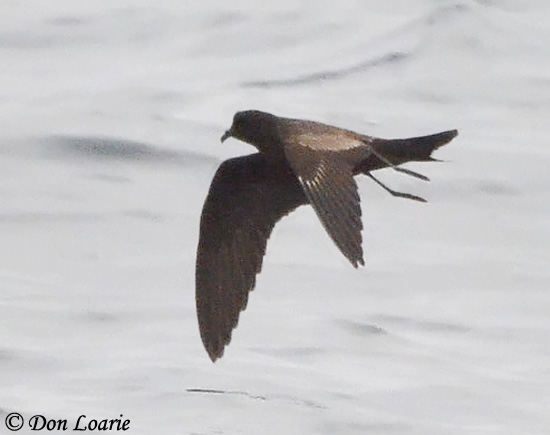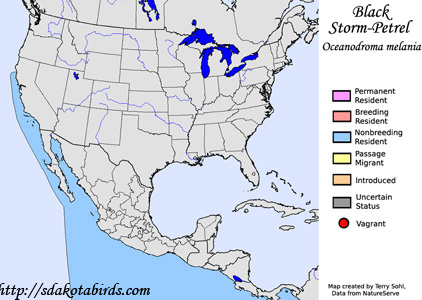| Length: 9 inches | Wingspan: 22 inches | Seasonality: Non-resident in South Dakota |
| ID Keys: Largest storm petrel in North America, dark overall, long forked tail, long narrow wings | ||
 The
Black Storm-Petrel is the largest Storm-Petrel found in North America.
They breed on select islands off Baja California, with much smaller numbers
nesting in a few spots off of southern California, where the first confirmed
breeding occurred in 1976. Many non-breeding birds disperse northward,
and the species can sometimes be quite common off the California coast
during the late summer and fall.
The
Black Storm-Petrel is the largest Storm-Petrel found in North America.
They breed on select islands off Baja California, with much smaller numbers
nesting in a few spots off of southern California, where the first confirmed
breeding occurred in 1976. Many non-breeding birds disperse northward,
and the species can sometimes be quite common off the California coast
during the late summer and fall.
Habitat: Found on rocky islands off the west coast of North America during the breeding season. Non-breeding birds are most often found in relatively warm ocean waters, usually far offshore, but can be closer to shore where warm waters and upwelling currents provide adequate foraging opportunities.
Diet: Feeds on small fish, crustaceans, and small squid. May also feed on other small marine creatures.
Behavior: Forages in Storm-Petrel fashion, flying low over the water's surface or hovering above the surface, and grabbing food items with its bill.
Nesting: The nest of a Black Storm-Petrel is a burrow or a crevice in the rocks. The nest itself may be nonexistent, or there may be a bit of vegetation. The female lays a single egg, with both parents helping to incubate it. After it hatches, both parents help to feed the nestling.
Interactive eBird Map: Click to access an interactive eBird map of Black Storm Petrel sightings
Song: Usually silent away from the nest site. At nesting sites, they have a long purring call.
Migration: Nests on scattered islands around Baja California and southern California, but the vast majority of breeding birds are found on the Islas San Benito islands off of Baja California in Mexico. After breeding, birds disperse northward, with many birds found off the California coast in the late summer and fall months. A majority of the population though likely winters off the northwest coast of South America.
Similar Species: In Range, very similar in appearance to Ashy Storm-Petrel, Leach's Storm-Petrel
Conservation Status: The population trend for the species appears to be downward, but they are still relatively common in parts of their range, and they are found over a wide geographic area. The IUCN lists the Black Storm-Petrel as a species of "Least Concern".
Further Information:
- Whatbird - Black Storm-Petrel
- Audubon - Black Storm Petrel
- California Bird Species of Special Concern - Black Storm-Petrel
Photo Information: Photo taken by Don Loarie - Photo licensed under Creative Commons Attribution NonCommercial ShareAlike 2.0 Generic License
| Click below for a higher-resolution map |
 |
| South Dakota Status: Non-resident in South Dakota |
Additional Black Storm-Petrel Photos (coming soon!!)
